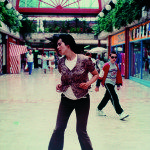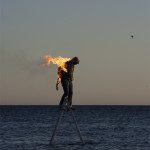Test Run: Performance in Public
Exhibition Dates: 28 March – 17 May 2015
Preview: Friday 27 March, 6.30pm
Press Preview: Friday 27 March, 11am-1pm
Piper Gallery, Project Space, Yard
To check opening times, please click here.
Günter Brus | Jeremy Deller | Song Dong | Rose English | VALIE EXPORT | Alicia Frankovich | Hamish Fulton | Jefford Horrigan | William Hunt | Sanja Iveković | Serena Korda | Bruce Lacey | Jérôme Leuba | Klara Lidén | Lilly McElroy | Florence Peake | Alex Schady | Mike Smith | Theatre of Mistakes | Gillian Wearing
Modern Art Oxford presents Test Run: Performance in Public – a multidisciplinary exploration of ideas which focuses on artists who use public space specifically for performance.
Through a selection of new and historical works, Test Run examines what happens when ‘normal behaviour’ in public spaces is disrupted and how expectations of public behaviour can be exploited.
Using film and documentary material, discussions and interactive sessions, Test Run explores the making, curating and presentation of performance in public space. Including live performance, talks, workshops and a series of three new commissions, Test Run links the interior space of the gallery to public locations in Oxford’s city centre.
Check the What’s On section for more information on events and performances.
To view and download the exhibition notes, please click here: Upward Mobility & Test Run Exhibition Notes
To view and download the activity guide, please click here: Upward Mobility & Test Run Activity Guide
Further information on artists exhibiting in Test Run: Performance in Public:
Jeremy Deller, The Battle of Orgreave (An Injury to One is an Injury to all), 2001
Jeremy Deller’s large-scale performance works are created in public, drawing on different traditions and linking back to political action. Community and collaborative work are key proponents of Deller’s films and in the exhibition Test Run: Performance in Public, Modern Art Oxford presents one of his most famous pieces, The Battle of Orgreave. Co-Commissioned by Artangel Collection and Channel 4, the film fuses re-enactment performances with archival footage of the miners strike in South Yorkshire in 1984, which ended in a pitch battle with mounted police. Staged seventeen years later, Deller’s spectacular, live re-creation embodies how far an idea can be taken encompassing the public in both research and performance.
For more information about the film, please click here.
Florence Peake, Lay Me Down
Florence Peake’s work Lay Me Down in Test Run: Performance in Public forms part of the Live Commissions section of the show. Peake works primarily with dance and sculptural elements, engaging the public in part-choreographed, part-rarefied dance in public spaces. In Test Run: Performance in Public, Modern Art Oxford presents Lay Me Down, a performance first developed in Nottingham which sees dancers and volunteers collaborating to bring their bodies at rest in public spaces – exploring interrupting conventions of public space and the verticality of public space.
For more information about Florence Peake, please click here.
VALIE EXPORT, TAPP und TASTKINO, 1968
TAPP und TASTKINO by Austrian artist VALIE EXPORT is one of the more overtly political pieces exhibited in Test Run: Performance in Public, which looks at the critical discourse on feminism and women’s roles in society. Politically charged, provocative and at times aggressive, the 1968 film shows the artist removing her clothes from the top half of her body, wearing a large cardboard box with an opening towards the front and encouraging the general public to “visit the cinema” by putting their hands in the box and feeling the artist’s body. Before being arrested for her performance, VALIE EXPORT engaged the public in an artwork demonstrating exhibitionism, feminism and voyeurism of cinematic conventions.
Mike Smith, Baby Ikki, 1978
American artist Mike Smith creates alter-egos in his work as a critique of contemporary culture. Although not always performed in public, the film Baby Ikki exhibited in Test Run: Performance in Public sees Smith physically embody his recurring persona as an oversized, nappy-wearing baby. By disrupting expectations of behavioural norms in public, the funny and ironic Baby Ikki is an ambiguous character to passers-by until a police officer fails to see the humour and calls an end to the performance.
Gillian Wearing, Dancing in Peckham, 1994
One of the most famous works by Gillian Wearing, Dancing in Peckham presents the artist in the gaze of a fixed camera shot, dancing in the midst of a busy shopping centre in Peckham. By taking a simple, enjoyable action and removing the music, placing the act in a public sphere takes on a political resonance. In the 25 minutes Wearing danced, shoppers occasionally glanced at the artist but not once did someone try and stop her or ask why she was dancing so intensely.
To see a clip of Dancing in Peckham, click here.
Günter Brus, Wiener Spaziergang, 1965
Almost in direct opposition of Wearing’s work is a film that created a stir in public, leading to the artist’s arrest. In Wiener Spaziergang, the simple act of painting his body and walking through the streets led Brus to be arrested by an officer, as documented in the film. Less than 30 years before Wearing danced in a shopping centre in South London, Brus also challenged the norms of how a person is to behave in public.
Hamish Fulton, new, live performance on Sunday 26 April
“Walking Artist” Hamish Fulton will be leading a special walk around Oxford beginning at the last strike of the bell at midday on Sunday 26 April and ending an hour later. Focusing on walking as a meditative practice, Fulton aims to show his group a different way of understanding public space.
Rose English, Quadrille, 1975
Rose English gathers a series of female performers all dressed in white, wearing horses feet and tails and act as though they are in a human version of a horse dressage event. Originally presented in the dressage arena at Southampton Horse show, the work examines the British class system and the fetishisation of women’s bodies.





